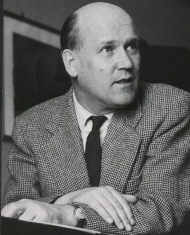 Willy
Burkhard (1900-1955)
Willy
Burkhard (1900-1955)
Willy Burkhard was an extremely influential composer of the 20th century. Burkhard was born in Evilard, Canton of Bern, Switzerland, which is the second largest canton in all of Switzerland. He attended and graduated from a teachers’ training college called the Muristalden and went on to study with E. Graf in Berne. His studies led him even further in his travels including Leipzig to study piano with Robert Teichmüller and composition with Sigfrid Karg-Elert. After Leipzig he moved on to Munich to study with Walter Courvoisier and later to Paris to work with Max d’Ollone.[1] It wasn’t until 1924 that he began teaching composition, theory and the piano in Berne. He was appointed to the conservatory there in 1928. He conducted several choirs and small orchestras there. In 1933 due to health reasons, he was compelled to live for several years in Montana and Davos for his own good. He settled in Zürich in 1942 and taught composition and music theory at the conservatory there. In 1950 he received a prize from the Schweizerischer Tonkünstlerverein or the Swiss Association of Musicians. Although Burkhard’s main interest was to compose for the voice, he is most commonly known mainly to have renovated church music. After his illness, the kindness and compassion that he received from his friends and loved ones led him to become deeply humbled and turn to religion. He wrote a large number of cantatas based on spiritual and biblical texts. Some of the reasons that he was partial to biblical texts were due to its simple yet interpretive language and its metrical forms.[2] Burkhard was one of the most original and diverse composers of his generation; he wrote operas, oratorios, sonatas, suites, serenades, cantatas, concertos, organ music, orchestral charts, and chamber music as well. Burkhard believed that it was the composers mission to go out on a limb to create and discover new modes of expression by combining the old ones, but never following already set musical fashions. The trick was to create a new unique sound that resounded as one solid stylistic sound as that reflected some of what the composer’s personality entailed. He would teach his students exactly this and never steer them away from their original findings.
Source: http://en.wikipedia.org/wiki/Willy_Burkhard
| Willy Burkhard | |
| Solo Harp | |
| Title - click titles for further information on this site | Instrumentation |
| Vier Intermezzi | Pedal Harp |